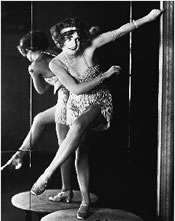
Photo of Bee Jackson, courtesy of Phrase Finder.
Talk amongst yourselves: What is the real-world definition of “the bee’s knees?”
I found a site today that fits the bill for this interesting phrase: Queens of Vintage. This is a light-hearted take on all things fashionista, historical and cultural–including interiors, clothing and zeitgeist–about the mid-20th century. One of my favorite periods, for all things about its “look and feel.” The only thing missing is some commentary on my friend Ben Storck’s Modern One, a furniture source for mid-century aficionados.
Here are some of the undeniable benefits from the so-called “mid century:”
- The fedora hat
- Red lipstick
- Fashions for women not requiring starvation or extreme diets..except for the latter 50s and into the 60s (we can overlook that)
- A magical time in American history, with innumerable innovations and forward-thinking positive attitude
Now that you’ve had a few moments to reflect on the meaning of “the bee’s knees,” I will spill the beans. This information, quoted directly from the Phrase Finder, includes origins from an Ohio newspaper and a 1920s flapper who was the World Champion Charleston Dancer. There are also additional word-lovers’ nuggets here too important to ignore, including a phrase often-used by my grandmother, “snake hips.”
So I’ve included the long excerpt, along with the site’s photo of Bee Jackson’s famous knees. Read on and enjoy….
There’s no definitive origin for ‘the bee’s knees’, but it appears to have been coined in 1920s America. The first printed reference to it I can find is in the Ohio newspaper The Newark Advocate, April 1922, under the heading ‘What Does It Mean?’:
“That’s what you wonder when you hear a flapper chatter in typical flapper language. ‘Apple Knocker,’ for instance. And ‘Bees Knees.’ That’s flapper talk. This lingo will be explained in the woman’s page under the head of Flapper Dictionary.” [an ‘apple knocker’ is a rustic]
Clearly the phrase must have been new then for the paper to plan to take the trouble to define it. Disappointingly, they didn’t follow up on their promise and ‘the lingo’ wasn’t subsequently explained. Several U.S. newspapers did feature lists of phrases under ‘Flapper Dictionary’ headings. Although ‘bee’s knees’ isn’t featured, they do show the time as being a period of quirky linguistic coinage. For example, from one such Flapper Dictionary:
Kluck – dumb person.
Dumb kluck – worse than a kluck.
Pollywoppus – meaningless stuff.
Fly-paper – a guy who sticks around.There’s no profound reason to relate bees and knees other than the jaunty-sounding rhyme. In the 1920s it was fashionable to devise nonsense terms for excellence – ‘the snake’s hips’, ‘the kipper’s knickers”, ‘the cat’s pyjamas’, ‘the sardine’s whiskers’ etc. Of these, the bee’s knees and the cat’s pyjamas are the only ones that have stood the test of time. More recently, we see the same thing – the ‘dog’s bollocks‘.
(Note: knickers weren’t underwear then – even for kippers. At least, one would hope not – the edition of the Newark Advocate above also had the headline ‘Bride Wears Knickers To Wedding’.)
One possible connection between the phrase and an actual bee relates to Bee Jackson. Ms. Jackson was a dancer in 1920s New York and is credited with introducing the dance to Broadway in February, 1924, when she appeared at the Silver Slipper nightclub. She went on to become the World Champion Charleston dancer and was quite celebrated at the time.
It’s not beyond the bounds of possibility that the expression was coined in reference to her (and her very active knees).
Now, armed with your new 1920s lexicon, go forth with dropped waist and meaningless lingo that will confuse all your friends. Personally, I am eagerly awaiting my next opportunity to leverage “the sardine’s whiskers.”
Leave a comment